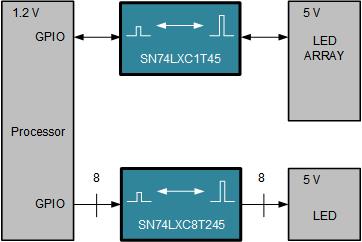-
Enabling LED and LCD Indicators in ModernSystem Designs SCEA115 August 2022 SN74LXC1T45 , SN74LXC1T45-Q1 , SN74LXC2T45 , SN74LXC2T45-Q1 , SN74LXC8T245 , SN74LXC8T245-Q1
-
Enabling LED and LCD Indicators in ModernSystem Designs
Enabling LED and LCD Indicators in ModernSystem Designs
1 Application Brief
Most people have experienced Wi-Fi® router issues. A critical part of trouble shooting Wi-Fi router issues is looking at the LED indicators that all Wi-Fi routers have to see what error is being reported or current device status. For many, flashing LEDs is a sign that something is working. As features and system complexities have increased, for electronic devices, the use of LEDs as status indicators has proliferated. Today, LEDs enable system designers to convey information such as system status, system warnings, power-up, and many other key system specific operation details. For system designers, using LEDs is the simplest and most cost-effective way to convey system information to users. LEDs have enabled system designers to develop products that are more user friendly and require less technical support.
System designers face design challenges when implementing status LEDs in their designs. The challenges occur because many newer FPGAs, processors, and microcontrollers in their systems are developed in smaller silicon process geometries. These geometries operate at lower core voltages, often < 1.8 V and have lower drive currents. The I/O of these newer lower-power processors and controllers often do not have the needed signal drive strength to drive LEDs, LCD modules, and multicolor LEDs that are used in new designs. Often, the I/O of modern processors have enough signal strength to drive short board trace or short cable runs between other circuits but not enough current to drive LEDs and small LCD displays.
To overcome the design challenges of driving LEDs with modern processors and controllers, designers are turning to higher current drive voltage translator devices to add needed current drive to their signals that drive LEDs and LCD modules. TI’s LXC family of direction-controlled level translators provides designers with voltage translators that have sufficient drive strength to drive LEDs. TI’s LXC voltage translation family is able to source up to 32 mA of output drive. The higher current source enables driving ICs that are connected through longer board traces. Additionally, the LXC devices can drive components requiring higher current such as LEDs and small LCDs which are common to the latest applications. With devices supporting different bit widths (1-bit SN74LXC1T45, 2-bit SN74LXC2T45, and 8-bit SN74LXC8T245), the LXC family has several different options for system designers for driving LED- and LCD-based designs (see Figure 1-1).
As signal chain components such as processors and micro-controllers continue their journey down the process curve, the current drive capability that these device I/O have will continue to diminish. Using simple logic level translation devices provides system designers a robust and cost-effective way to implement LED indicators in their systems without having to re-engineer their processor I/O.
For more information on TI’s LXC family of direction-controlled voltage translators, refer to TI’s translation landing page.
| Device | Description |
|---|---|
| SN74LXC1T45, SN74LXC1T45-Q1 | 1-bit, 1.1-V to 5.5-V translator |
| SN74LXC2T45, SN74LXC2T45-Q1 | 2-bit, 1.1-V to 5.5-V translator |
| SN74LXC8T245, SN74LXC8T245-Q1 | 8-bit, 1.1-V to 5.5-V translator |
 Figure 1-1 Processor Driving LED Example
Figure 1-1 Processor Driving LED ExampleIMPORTANT NOTICE AND DISCLAIMER
TI PROVIDES TECHNICAL AND RELIABILITY DATA (INCLUDING DATASHEETS), DESIGN RESOURCES (INCLUDING REFERENCE DESIGNS), APPLICATION OR OTHER DESIGN ADVICE, WEB TOOLS, SAFETY INFORMATION, AND OTHER RESOURCES “AS IS” AND WITH ALL FAULTS, AND DISCLAIMS ALL WARRANTIES, EXPRESS AND IMPLIED, INCLUDING WITHOUT LIMITATION ANY IMPLIED WARRANTIES OF MERCHANTABILITY, FITNESS FOR A PARTICULAR PURPOSE OR NON-INFRINGEMENT OF THIRD PARTY INTELLECTUAL PROPERTY RIGHTS.
These resources are intended for skilled developers designing with TI products. You are solely responsible for (1) selecting the appropriate TI products for your application, (2) designing, validating and testing your application, and (3) ensuring your application meets applicable standards, and any other safety, security, or other requirements. These resources are subject to change without notice. TI grants you permission to use these resources only for development of an application that uses the TI products described in the resource. Other reproduction and display of these resources is prohibited. No license is granted to any other TI intellectual property right or to any third party intellectual property right. TI disclaims responsibility for, and you will fully indemnify TI and its representatives against, any claims, damages, costs, losses, and liabilities arising out of your use of these resources.
TI’s products are provided subject to TI’s Terms of Sale (www.ti.com/legal/termsofsale.html) or other applicable terms available either on ti.com or provided in conjunction with such TI products. TI’s provision of these resources does not expand or otherwise alter TI’s applicable warranties or warranty disclaimers for TI products.
Mailing Address: Texas Instruments, Post Office Box 655303, Dallas, Texas 75265
Copyright © 2022, Texas Instruments Incorporated